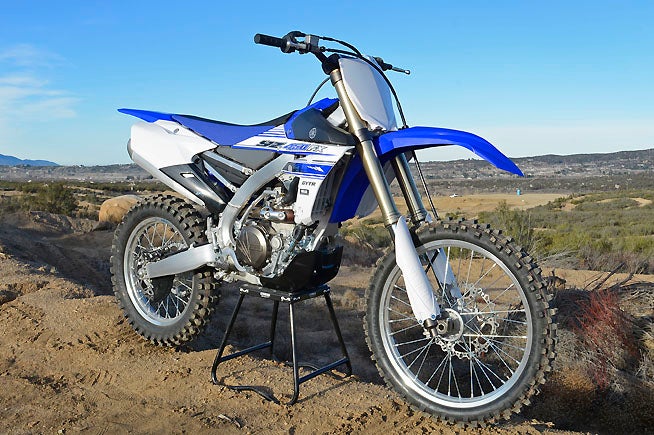Can Yamaha’s all-new YZ450FX cross country racer topple the dominance of the Orange Brigade?
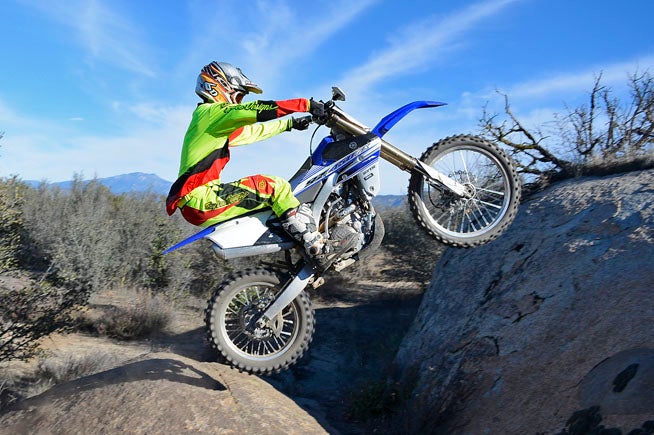
When Yamaha invited us to ride its all-new YZ450FX cross country racer at Southern California’s Cahuilla Creek Motocross Park near San Diego, we already knew we were in for a good time.
The facility’s sprawling layout offers not only a full motocross track, it also features plenty of single-track trails and boulder-infested terrain to allow proper vetting of any off-road motorcycle’s capabilities. This is the same site where we got acquainted with Yamaha’s 2015 YZ250FX, a machine that went on to outsell its next closest competitor by a factor of three, according to Yamaha. How, then, could Yamaha miss the mark by converting its World Motocross Championship-winning YZ450F into a race-ready off-road contender? In terms of performance we can tell you that the answer is “not at all,” and in terms of the overall package, the answer is “not by much.”
And after spending a few hours on the bike, we can state in full confidence that Yamaha has another potential hit on its hands. The YZ450FX isn’t some watered-down motocross machine detuned for off-road use. It harnesses the mighty power and quick handling of the YZ450F in a machine specifically tailored to win at the highest levels of off-road competition. To prove its mettle, we enlisted Southern California off-road privateer Nic Garvin, who contests the Pro class in the Kenda SRT/AMA National Championship Hare & Hound Series aboard a KTM, to hammer the FX and give us his thoughts. After taking a few loops of Yamaha’s nicely executed Cahuilla off-road loop, Garvin was impressed.
“Honestly, I was skeptical that it could be a great off-road bike when I first looked it over because it was missing some things that you would expect on a stock off-road bike,” Garvin said. “It has a skid plate, the shark fin to protect the rear brake disc and the 18-inch rear wheel, but it was missing other obvious things like handguards and a larger fuel tank [the stock FX tank holds 2.0-gallons of fuel, same as the YZ450F]. But when I rode it I was impressed with how aggressive the power is while still being smooth and controllable. Right off the bottom it has a lot of torque, which makes it easy to ride. All you have to do is grab a handful of throttle, and it just rips. The midrange power is really smooth, and it has plenty of top-end. Before you know it, you’re really moving.”
Of course, the YZ450F, with its mass-centralizing, rearward slanted, liquid-cooled, fuel-injected, DOHC, titanium-valved, 449cc four-stroke Single, is the starting point for the FX. The FX’s 97.0mm x 60.8mm bore and stroke are identical to the YZ450F, as are its 12.5:1 compression ratio and Yamaha Fuel Injection (YFI) system, which utilizes a Keihin 44mm throttle body. The FX’s double overhead cams even use the same lift and duration specs as the YZ’s. The only difference is a slight relocation of the decompression mechanism.
That said, there are significant differences that set the two models apart. First and foremost is the FX’s convenient electric start system (a kickstarter is still employed as a backup). The two models still use the same engine cases—look at the front of any ‘16 YZ450 engine, under the exhaust port, and you will see the mounting bosses for the FX’s electric starter. The only real visible difference is that the FX’s ignition cover is slightly wider to accommodate the heavy-duty, 160-Watt generator assembly that keeps the FX’s battery charged and also allows for the addition of accessory lighting.
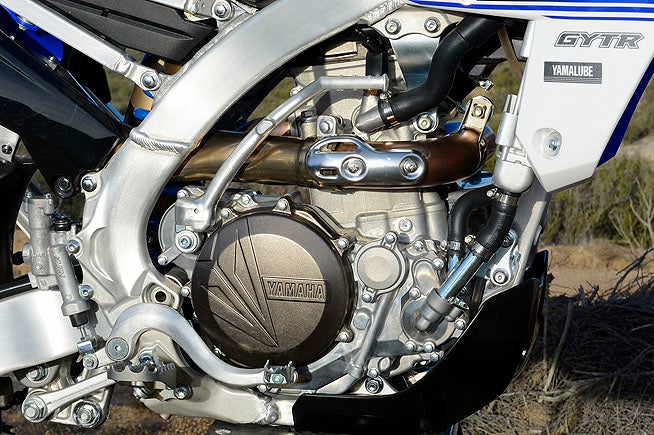
The FX’s ECU is also different than the YZs, and the two ECUs are not interchangeable. The FX’s unit is tuned to deliver a different style of power to meet the needs of cross country racing as opposed to motocross, and it also features additional leads to run the electrical system. Like the YZ’s ECU, it can, however, be tuned to alter the engine’s power delivery via Yamaha’s handy accessory GYTR Power Tuner. It should also be noted that the FX’s ECU is also sold by Yamaha as an accessory for WR riders who want it, although the swap surrenders the WR’s Green Sticker-compliant status.
After a few more loops aboard the bike with the stock ECU settings, we went ahead and had Yamaha factory test rider Travis Preston retune the bike with the GYTR Power Tuner [see table above] before sending Garvin back out on the trail. These are not the same settings Preston uses when dialing-up the YZ450F’s power curve because the base settings differ between the FX and the motocrosser. That said, Preston’s personal FX settings work equally well, and they make a noticeable difference in the engine performance. Garvin returned even more pleased with the FX’s power delivery.
“If I was going to race this bike, I would insist on making the ECU changes,” he said. “It is already very good in stock form, but going in and changing a few settings with the power tuner really makes the engine come alive. The changes give it a lot more snap everywhere. It’s a lot more responsive and aggressive, yet it doesn’t lose any of its smoothness throughout the rev range.”
There are differences to the FX’s internals as well, the biggest of these being a wide-ratio five-speed transmission that incorporates steeper first and second third gear ratios for crawling through technical sections and a taller fifth gear ratio for high-speed riding across open terrain. Yamaha says that the gearing is 30 percent wider than the YZs. The FX’s 13/50 final drive gearing is only two teeth steeper than its motocross sister, but the variance in first gear alone is the equivalent of adding 13 teeth to the YZ’s rear sprocket while fifth gear’s “overdrive” is the equivalent of taking four teeth off the YZ. Even though the FX’s transmission ratios aren’t as close as the YZs, Garvin was impressed with just how much pull each gear offered—at least from second gear on up to fifth.
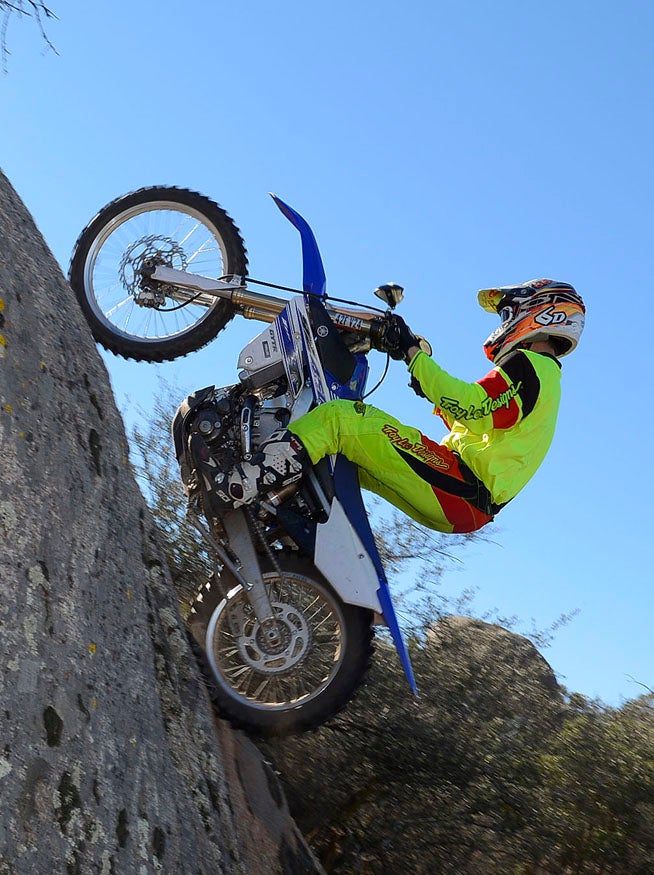
“First gear isn’t something that I would find myself needing to use for desert work because it is so short, but I could see it in GNCC racing,” Garvin said. “Even in tight stuff, I was impressed with how much range I had with second gear, and if I was just out trail riding, I would probably leave the bike in third gear most of the time. The engine is such a tractor, and it just pulls third gear really well even on tight single-track trails. Fifth gear definitely makes this bike go fast! It would be great for the desert. Fourth is already fast, but this gear is just over the top. The funny thing is, I think that the FX can be really versatile. If you hadn’t told me that this isn’t a motocross bike, I would be totally happy taking it out on the track and racing motocross with it.”
The FX’s cable-actuated clutch (no hydraulics here) is also significantly changed to meet the needs of off-road racing versus motocross. Its clutch pack utilizes different plates designed to better withstand abuse from slipping the clutch, such as when the rider is forced to paddle up a tight and/or slippery uphill section. Lighter clutch springs, a 5mm shorter actuator arm and an added bushing are also used to make the FX’s clutch action lighter, smoother and give it a wider range of play in the friction zone. Yamaha also added a judder spring to the FX clutch hub for better shock resistance for instances when the rear wheel catches a big rock or root.
Garvin offered high praise for the clutch’s feel, although he did note, “I’m used to a hydraulic clutch, so I did have to use the adjuster on the clutch perch to keep the action where I wanted it.”
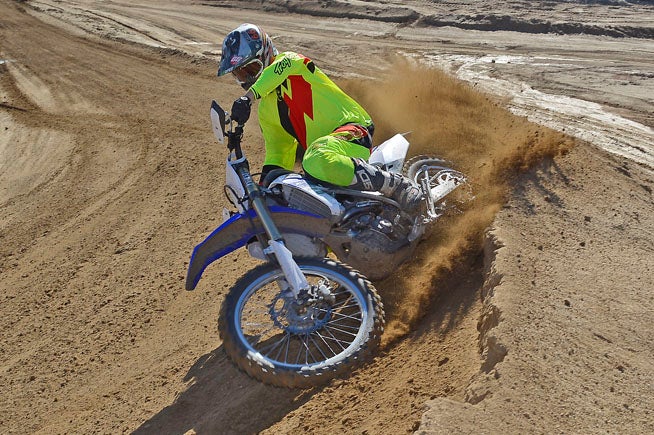
Other subtle but no less substantial differences include a lighter crankshaft to offset the additional reciprocating weight of the FX’s larger ignition rotor. It’s also balanced differently than the YZ’s crank, delivering a 100 percent balance factor compared to the YZ’s 88 percent balance factor. Yamaha claims that the FX’s crank balance factor translates into less engine vibration, which can help reduce rider fatigue during the course of a three- or four-hour off-road race. The FX’s counterbalancer also incorporates a heavier weight to help ward off unwanted engine vibes.
The FX chassis geometry is identical to the YZ’s, but Yamaha has tuned the chassis flex for off-road use by swapping to engine mounting brackets that are 2mm thinner than the 8mm units found on the YZ. They’re also shaped differently. Yamaha already tweaked the 2016 YZ450F’s chassis for better bump compliance by adjusting the fork offset to deliver more front-end feel and better turning stability and switching to frame spars that are 12mm wider at the swingarm pivot; the YZ450FX incorporates these changes as well.
For flat out off-road use, the FX chassis generally delivers very good handling, although its moto roots are evident. Its steering is light, but Garvin noticed that he had to work at tight switchbacks, and through technical rocky sections at low speeds because of what he calls a “top-heavy” feel. At higher speeds, he also noticed the front end was a tad nervous.
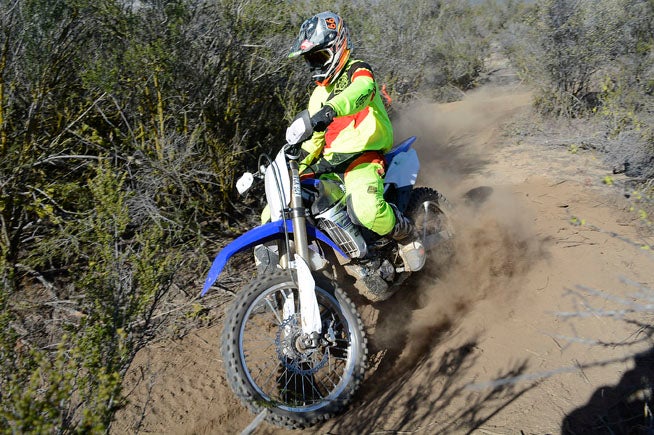
“There are other stock off-road bikes that are more stable at high speeds” Garvin said. “If this was my bike, I would spend a lot more time dialing in the suspension settings to see if I could eliminate the twitch completely, but if I couldn’t, I would just put a steering damper on it, like a Scott’s or a GPX, and it would be fine. Overall, though, it handles well. It carves sand turns well, although sometimes the front end will ‘knife’ in flat turns. It also tracks well through rutted corners—it doesn’t want to dart right or left.”
The YZ450FX carries the latest generation 48mm KYB Speed Sensitive System (SSS) fork, which uses coil springs and dampers in both legs, instead of air, and is fully adjustable for compression and rebound damping. Out back is a KYB piggyback shock that offers preload, high- and low-speed compression damping, and rebound damping adjustability. Both ends differ from the YZ450F in that their valving is softer for off-road use. The fork spring rate is reduced from the motocross bike’s 5.0 N/mm to 4.5 N/mm, while the shock spring rate is the same 56 N/mm as the YZ450F, which saw its shock spring rate reduced from 58 N/mm for the 2016 model year.
Out on the trail, Garvin noted that the front and rear suspension are more than competent, although he did have Yamaha’s techs back off two clicks on the fork compression and add two clicks of low-speed compression to the shock to balance the bike for his tastes and eliminate what he described as a tendency for the rear to bottom over big hits. Both ends deliver smooth and controllable travel for off-road use, although Garvin hinted that most pro riders might like the valving to be just a bit more aggressive than the stock suspension delivers. He had no complaints with the spring rates.
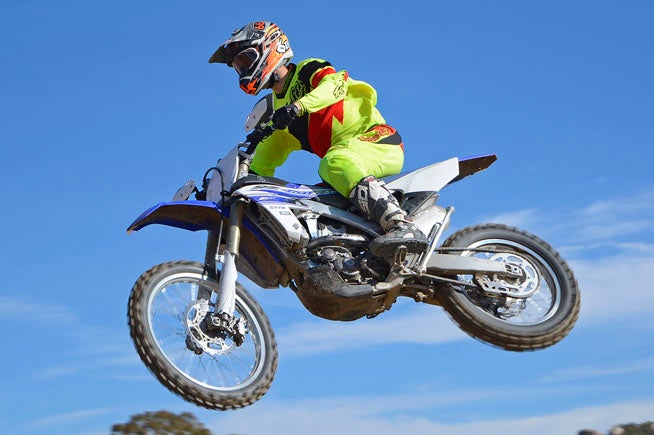
“The stock suspension on this bike is really plush, and the forks are really nice, but if you bottom the rear end over a dropoff or in deep braking bumps, it really clanks.”
The FX’s brakes are identical to the YZ’s. The 270mm front disc and Nissin two-piston caliper delivers strong and linear stopping power, and the same goes for the 245mm rear disc and single-piston caliper out back. Garvin said he is a fan of Yamaha’s brakes.
“They stay strong and smooth without fading or getting grabby—I wasn’t able to get them to overheat,” he said. “That’s exactly what you want on an off-road bike. The front brake is really, really good.”
Ergonomically speaking, the Yamaha is as narrow as a rail, offering a slim, flat seat and narrow radiator shrouds that allow the rider to easily shift his or her seating position as needed. Despite its profile, the seat doesn’t punish the posterior on long rides.
“It’s really comfortable,” Garvin said. “It’s seating is such that you feel like you are really on top of the bike and can control it. I like the bar bend, which is a little lower than I am used to but fit this bike’s ergonomics perfectly. I’d have no trouble racing it in stock form.”
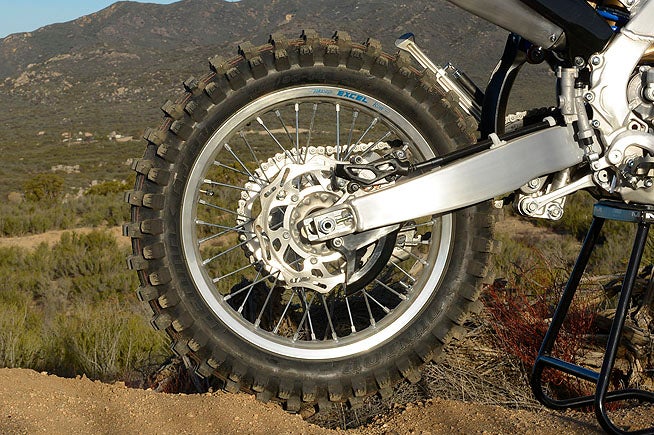
An 18-inch rear wheel is a virtual necessity for off-road racing, as the greater tire sidewall distance between the rim and the ground gives the tire more flex for better traction and better flat resistance. The FX features an 18-inch rear wheel, and both the front and rear wheels are shod with Dunlop’s excellent AT81 off-road tires, which deliver excellent traction and feedback in a wide variety of off-road conditions.
Yamaha sweated many of the details on the 2016 YZ450FX. For instance, it is equipped with the aforementioned heavy-duty skid plate and rear disc sharkfin. That’s an improvement over the 2015 YZ250FX, which should have come from the factory with a skidplate, but didn’t. The FX also features radiators with a different fin pitch than the YZ to allow for better airflow through the radiators at low speeds. The FX radiators also feature bosses for the addition of Yamaha’s accessory radiator fans.
However, even though its $8890 asking price is less than its Euro-bred competition, we would like to see the FX come from the factory fitted with the accessory GYTR handguards that we fitted to our stock machine. Yamaha sells them for $150. We also think that the FX deserves more fuel capacity in stock trim, and before you go thinking that this is a case of the YZ’s mid-mounted fuel tank layout prohibiting such a thing, don’t. IMS Products sells a 2.9-gallon tank for YZs, and Yamaha has already added the tank to its accessory catalog. For the FX to be truly off-road race ready, we say a larger tank should be included as part of the stock package.
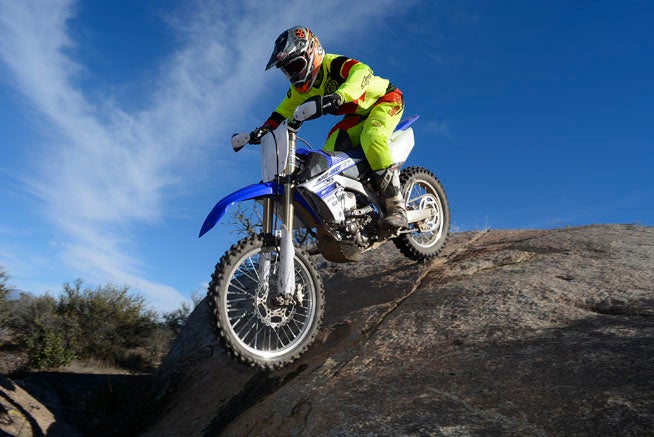
Is that nitpicking? Maybe. Overall, we really like Yamaha’s new open-class off-road racer. That should come as no surprise since we loved the YZ250FX and have been impressed with the progress that the company has made in developing the YZ450F platform during the 2015 and 2016 model years. In fact, if we had to choose between the two models, we would probably go with the YZ450FX by virtue of its wide-ratio transmission and electric start. For our money, the YZ450FX may just be the most versatile dirtbike on the planet today.
2016 Yamaha YZ450FX Specifications
MSRP: $8890
Engine: Type 449cc liquid-cooled DOHC 4-stroke; 4 titanium valves
Bore x Stroke: 97.0mm x 60.8mm
Compression Ratio: 12.5:1
Fuel Delivery: Yamaha Fuel Injection (YFI) Keihin 44mm throttle body
Ignition: TCI: Transistor Controlled Ignition
Transmission: Wide-ratio constant-mesh 5-speed; cable-operated multiplate wet clutch
Final Drive: O-ring chain
Front Suspension: 48mm KYB spring-type fork with Speed Sensitive System damping; fully adjustable, 12.2-in. of wheel travel
Rear Suspension: KYB single shock; full adjustable; 12.5-in. of wheel travel
Front Brake: Hydraulic single disc brake, 270mm
Rear Brake: Hydraulic single disc brake, 245mm
Front Tire: Dunlop MX51 80/100-21
Rear Tire: Dunlop MX51 120/90-18
L x W x H: 85.2 in x 32.5 in x 50.4 in.
Seat Height: 38.0 in.
Wheelbase: 57.7 in.
Rake: (Caster Angle) n/a
Trail: n/a
Ground Clearance: 12.8 in.
Fuel Capacity: 2.0 gal.
Wet Weight (claimed): 262 lbs.
Warranty: 30 Day (Limited Factory Warranty)
Color: Team Yamaha Blue/White
